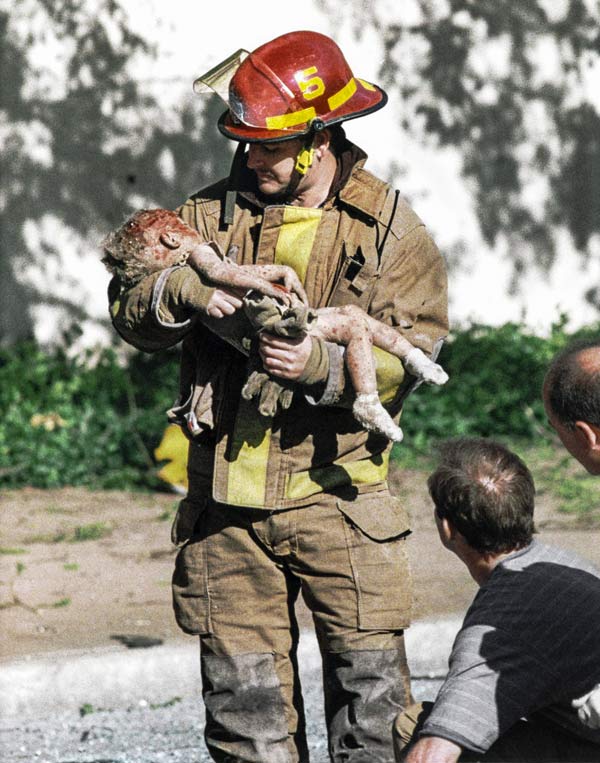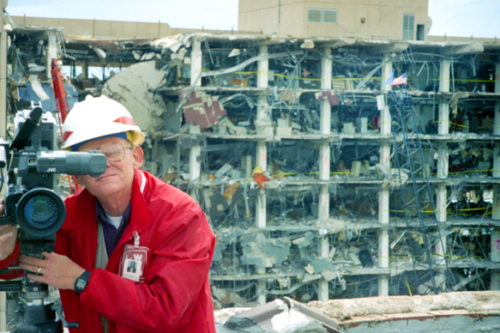History Through Pulitzer: “Oklahoma City Bombing”

Pulitzer Prize-winning photo taken by Charles Porter IV on April 19, 1995 in Oklahoma City, Oklahoma following the bombing of the Alfred P. Murrah Federal Building. The photo was distributed by The Associated Press.
Do you recognize this image? It came to symbolize the lives lost in the deadliest act of homegrown terrorism in U.S. history, the 1995 Oklahoma City bombing. In 1996 the photo was awarded a Pulitzer Prize in Photography for Spot News.
THE STORY BEHIND THE PHOTO
On the morning of April 19, 1995, Charles Porter IV was working in the loan department of Liberty Bank in Oklahoma City when a massive explosion jolted his office. “To me, it was a sonic boom,” said Porter. “We looked out the window and we saw this big brown cloud of debris and dust.” A photographer in his spare time, Porter grabbed his camera from the trunk of his car and rushed to the scene. The Alfred P. Murrah Federal Building looked like a war zone. Broken glass littered the street. Rescue workers pulled bodies from the rubble. Bleeding victims staggered from the wreckage. The entire front of the building was gone. “It was just like it had been shaved off,” said Porter. Out of the corner of his eye, Porter saw a police officer hand something to a firefighter. “I didn’t know what he was carrying,” he said. “The next frame I took was the fireman holding this infant.” The bombing killed 168 people. Among the dead were 19 children, including 1-year-old Baylee Almon, the girl in the photo.
DOCUMENTING THE DESTRUCTION
By Omaha Photographer Bob Etzel
“For me, this photo brings back many memories. Not only does it show how first responders go into harm’s way to aid those in need but how, during disasters, many people come together to provide assistance where needed. I observed this first-hand after the Alfred P. Murrah Federal Building was bombed in Oklahoma City on April 19, 1995.
I first heard about the bombing on the radio while in my office in Omaha’s Zorinsky Federal Building. I turned on the network news channel to watch the broadcast. I was working as a photographer with the Army Corps of Engineers, Omaha District, at the time.
The next day, April 20th, I received instructions that the Omaha District was sending a team down to Oklahoma City to help document the damage, per a request from the Bureau of Alcohol, Tobacco and Firearms (ATF). The Federal Bureau of Investigation (FBI) was in charge of the criminal investigation and was acting separately.
On the 21st, myself and two structural engineers flew down to Oklahoma City and checked into the Corps office there. We received a briefing and were given photo IDs to be used as passes to get into the secure area. After being briefed, we reported to the ATF office in a trailer for further instructions. We went to the explosion site where I took photos. Then onto the warehouse, where evidence was being stored, to photograph items such as remnants of the truck that had been packed with explosives. We were even able to get into the Murrah Federal Building to document damage from within. Surprisingly, a couple of the elevators were operationally sound so we could use them. I took nearly a thousand photos and several hours of videotape documenting the damage and cleanup activities. I was overwhelmed by the damage that was done and the loss of life.
We also documented structural damage to the buildings surrounding the site, photographing the buildings within a mile (360-degree radius) from the explosion. An aircraft was also used to provide aerial photos to scale (modified C130). In addition, the ATF had obtained a truck like the one used by the bombers and set it up to show how it was done. I videotaped the event with an agent explaining how the explosive was set off. The video was sent to ATF headquarters by an aircraft from Tinker Air Force Base. The work we did in Oklahoma has since been used to inform new building codes and safety standards for the construction of federal buildings. The cooperation between agencies, for the most part, made the cleanup effort go fairly smooth. We all were keenly aware of the somber emotional impact of what we were doing.
The bombing killed 168 people, including 19 children, and damaged or destroyed over 300 buildings. Among the tragedy, heroes stepped forward (like the firefighter in this Pulitzer photo) and a community came together to help each other and even new arrivals, like us. During our stay, many volunteer organizations provided us food and needed supplies on-site. Despite the sadness, the community’s spirit of togetherness was unbroken.”
About Bob Etzel
A Kodak Brownie Holiday. That was the camera Bob Etzel received for his 8th grade graduation present. After joining the Air Force in February 1965, he bought his first 35mm camera in Thailand, a Canon FX SLR. Following his return to the U.S., he joined the U.S. Army Corps of Engineers in the Photo Unit as an apprentice. His on-the-job training was supplemented with classes at Metro Tech, resulting in an Associate Degree in Commercial Photography. As a staff photographer for the Corps, Bob documented construction projects related to the Omaha District, as well as, documenting responses to natural and man-made disasters, such as the Alfred P. Murrah Federal Building bombing in Oklahoma City.
In 1997, Bob took the position of Branch Chief of the Customer Assistance Branch in the Information Management Division before retiring from the Corps in June of 2007. The following year he became a volunteer at The Durham Museum, utilizing his photography skills to photograph artifacts for the online archive. In 2017 Bob was honored with a Volunteer Achievement Award for Mission Impact. He and his wife Barb also photograph special events at the museum.
VIEW CURRENT EXHIBITS
The “Pulitzer Prize Photographs” exhibition is on display at The Durham Museum from February 22 – through September 20, 2020. The exhibit features the most comprehensive collection of Pulitzer Prize-winning photographs ever assembled and was developed by the Newseum.



